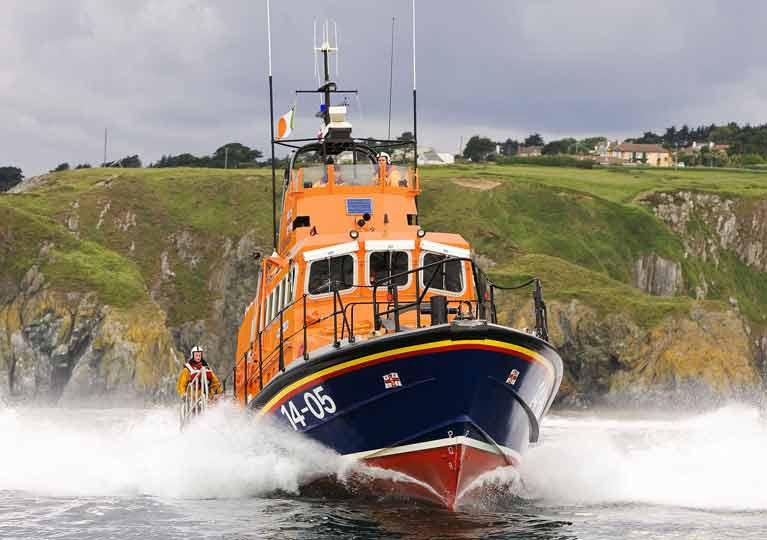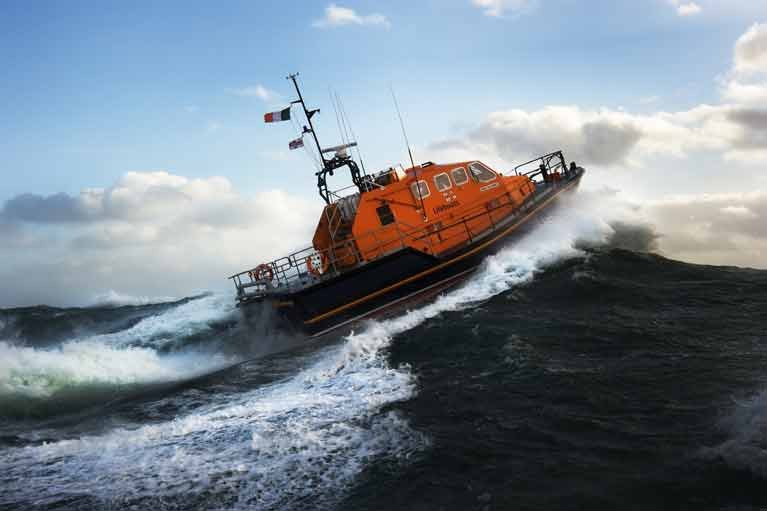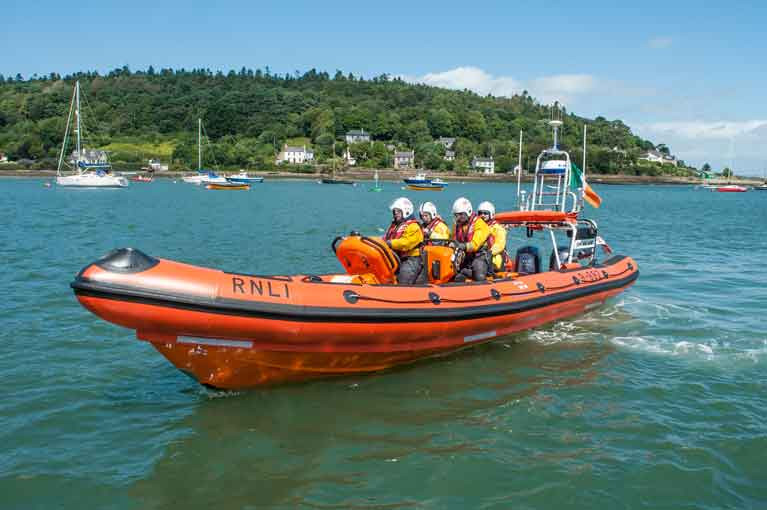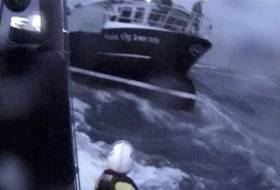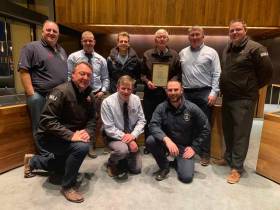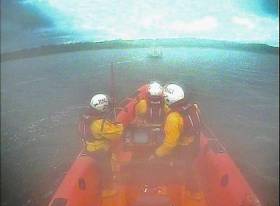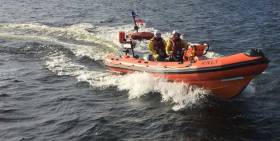Displaying items by tag: Lifeboat
Annalise Murphy Joins 29er's Virtual Cycle Round Ireland
Olympic sailing silver medalist Annalise Murphy joined four Dun Laoghaire-based 29er sailors and their coach in their bid to ‘virtual cycle’ around Ireland in aid of the RNLI.
As Afloat reported earlier, Max Goodbody, Nathan van Steenberge, Sam Ledoux and Tim Norwood, along with coach Thomas Chaix, have taken on the epic route via every lighthouse around the island of Ireland — but covering the distance on stationary bikes in their own homes.
Last night the Irish sailing superstar from Rio 2016 joined the four boys for an 85 km stretch. Like everyone else, the National Yacht Club dinghy star is adapting to a new life with Coronavirus as Afloat reported previously here as she aims for the Tokyo 2021 Olympics.
Since starting on Saturday 9 May, the 29er boys have already covered the distance from Dun Laoghaire to West Cork — and that’s around their home school commitments, too.
The team aims to complete the 2,000km route — with 14,000 metres of climbing — in 11 days while raising funds for the charity that saves lives at sea.
Annalise is not the only Tokyo Laser trialist to join in either. Howth's Aoife Hopkins has also been on the journey. Donaghadee's Finn campaigner Oisin McClelland was also on the route from Castletownbere with coaching staff tagging along too.
Already exceeding their initial target of €2,000, the team have so far raised over €5,000 to keep the RNLI afloat in uncertain waters.
RNLI Plans Reduced Lifeguard Service This Summer due to Coronavirus Outbreak Challenges
Despite the challenges of the coronavirus outbreak, the Royal National Lifeboat Institution (RNLI) hopes to provide a lifeguard service on around 30% of the beaches the charity usually covers this summer, if government guidance allows.
The rollout of the normal seasonal lifeguard service was paused at the end of March due to the measures put in place by the Government to control the spread of Coronavirus. In the anticipation that there may be changes to the lockdown restrictions in the coming weeks and months allowing the public to visit beaches around the UK and Channel Islands, the RNLI has been looking at plans to resume a lifeguard service where possible.
This needs to be consistent with government guidance but the plan is for the service to build in time so that lifeguard patrols reach 70 beaches across the UK by peak season. Beaches will be chosen based on risk and popularity. The RNLI will also look to achieve a geographical spread while making sure the service provided is flexible and sustainable enough to respond to what may be an ever-changing environment.
RNLI Chief Executive, Mark Dowie, said: ‘The RNLI is incredibly proud of its highly skilled lifeguards who work alongside the charity’s volunteer lifeboat crews, HM Coastguard and other emergency services. RNLI lifeguards are professional lifesavers and will be essential when the lockdown is lifted and people head to our coastlines and enjoy our beautiful beaches.
‘The current situation means that the operational logistics and training behind setting up a lifeguard service – normally in full swing at the moment – have had to stop. Re-establishing this infrastructure and distributing equipment to beaches will take time. And we must also make sure that conditions are safe for our lifeguards to provide an effective service – our priority remains the safety of our people and the public.
‘But despite these challenges, and given enough notice of lockdown lifting, we’re hoping to put lifeguard patrols on around 70 beaches across the UK and Channel Islands.
‘We are planning for a service that we can adapt to changes in Government guidelines and restrictions. We don’t know whether people will be allowed to visit beaches, what social distancing restrictions will be in place, or whether we’ll have periods where restrictions are relaxed and then reintroduced. We’re also looking at how we provide our lifeguard service – we may have a more agile service that can adapt to changing circumstances – so it may look a little different to previous years. And we’re working with local councils, landowners and partners to make sure the environment lifeguards return to is safe and appropriate precautions are in place.
‘While the main challenge of rolling out a lifeguard service will be logistical, as a charity we do also need to consider the financial challenge we currently face and our fall in income due to restrictions on how we can fundraise.
‘The reduced lifeguard service will continue to be supported by our lifeboat stations around the coast. Our lifeboat volunteers have been on call 24/7 to help those in trouble at sea throughout the coronavirus outbreak – and will continue to be so this summer. We will also be giving water safety advice throughout the summer. During the coronavirus outbreak, we have seen great examples of people coming together, so our focus is to work with the public to succeed in ensuring the coast is a safe place to visit when restrictions are lifted.’
The RNLI is urging everyone to follow current Government instructions until these restrictions are lifted. The guidance is clear: stay home, protect the NHS and save lives. While you are allowed outside for daily exercise, we do not recommend that this exercise is on or in the sea. If you are able to visit the coast for your daily exercise while adhering to Government advice, we urge you to remember the following RNLI safety advice:
- Take care near cliffs - know your route and your limitations
- Check the weather forecast and tide times
- If you fall into the water unexpectedly, FLOAT TO LIVE. Fight your instinct to thrash around, lean back, extend your arms and legs, and float
- In any coastal emergency dial 999 or 112 and ask for the coastguard
Dun Laoghaire RNLI came to the aid of two people who got into difficulty on a kayak this morning.
The volunteer lifeboat crew were paged at 8.21 am following an initial report from the Irish Coast Guard that two men were in difficulty on a kayak somewhere between Dalkey Island and Coliemore Harbour.
The casualties used a mobile phone to raise the alarm when the kayak they were on began to drift out to sea.
The all-weather lifeboat under Coxswain Mark McGibney and with four crew members onboard launched immediately and made its way to the scene. Dun Laoghaire Coast Guard shore unit also attended.
Weather conditions at the time were described as good with a calm sea, light wind and good visibility.
On arrival south of Dalkey Island, the lifeboat crew observed that a fishing trawler that had arrived on scene first had taken the kayak in tow. The two kayakers who were safe and well were then transferred onto the lifeboat and brought back to Dun Laoghaire where no further medical attention was required.
Speaking following the call out, Stephen Wynne, Dun Laoghaire RNLI Lifeboat Operations Manager said: ‘The casualties did the right thing this morning and called for help once they knew they were in difficulty and that the vessel was drifting out to sea. We would like to wish them well and thank the fishing crew that was first on scene for their assistance this morning.
‘Dun Laoghaire RNLI remains on call and is fully operational during the Coronavirus pandemic. While there is no crew training or exercises taking place, our volunteers are here if people need us.’
The RNLI has issued advice with the Irish Coast Guard, to ask people to avoid using the water for exercise while restrictions are in place. This is to minimise the risk to search and rescue volunteer crews, helicopter crew and other frontline emergency services, through being unintentionally exposed to the coronavirus.
The charity meanwhile, has today launched its annual Mayday fundraising appeal. While crews around Ireland remain on call, the pandemic means that fundraising cannot take place as normal. The RNLI is instead asking people to consider fundraising at home to help save lives at sea. To find out more or to donate, log on to rnli.org/Mayday
Comedian PJ Gallagher Backs RNLI’s ‘Mayday’ Appeal to Fundraise at Home During Coronavirus Restrictions
Lifesaving charity, the RNLI (Royal National Lifeboat Institution), is encouraging people to help save lives at sea and on inland waters by fundraising at home for its annual Mayday fundraising appeal. The RNLI’s Mayday campaign normally sees people taking part in group fundraising events around Ireland but, due to the Coronavirus pandemic, the lifeboat charity is taking the campaign online. Broadcaster, comedian and Dun Laoghaire RNLI volunteer PJ Gallagher is backing the RNLI’s Mayday appeal and urging people to get creative for the lifeboats and raise funds from home.
Although the country is staying at home for now, the charity’s volunteer lifeboat crews are still on-call 24/7, ready to drop everything when their pager sounds, to save lives at sea and on inland waters. Irish lifeboat crews have been on rescue missions during the restrictions and are fully operational. The charity is calling on the public to help raise funds for its vital lifesaving service by getting active and joining a step count challenge, having a cuppa for the crew or taking the H2only challenge for its online Mayday appeal.
To get people in the mood, a Dublin RNLI volunteer crewmember is making the best of the lockdown which has seen his gym close, by throwing his weight behind Mayday. Howth RNLI crewmember and owner of Toned Fit gym, Ronan Murphy, is going to help members of the public get active and make their steps count for Mayday. The crewmember will be sharing his session online on Howth RNLI’s Facebook page with other stations being asked to join him in the challenge. He has also extended PJ an online fitness challenge to encourage others to get involved and to have a little fun for Mayday while they are stuck inside. Ronan’s gym normally holds a Mayday fundraiser to lift the weight of a RNLI all-weather lifeboat to raise funds.
Commenting on the RNLI’s Mayday campaign, PJ Gallagher said: ‘It is difficult for charities at the moment as the current restrictions mean that we can’t support them in the usual way. The RNLI is very close to my heart as I know first-hand the work they do and it is an incredible feeling to be able to save a life or help someone in trouble on the water, knowing that you have been provided with the proper kit and training to do it.’
‘The RNLI has had to move Mayday online and I hope that people will follow them there. There are plenty of ways to raise funds and I am going to take up Ronan’s fitness challenge, to show how easy it is to raise funds for the RNLI and keep fit in the process. The ‘Make Your Steps Count for Mayday’ is just one way to fundraise and rnli.org/mayday has more suggestions. If you don’t feel like getting active you can simply donate online at rnli.org/mayday and feel good about it.’
RNLI Fundraising Manager Danny Curran says: ‘Our Mayday fundraising campaign is a vital event in the RNLI calendar and given the current situation it is more important than ever. For years, our fantastic fundraisers have given their time and energy in May to help our lifesavers. But the welfare of our volunteers, staff and supporters is our priority, and the usual range of activities are now impossible. So, this year, Mayday will look a bit different.
‘While many fundraising events and gatherings have been cancelled, our lifeboat volunteers are still responding to their pagers and launching in lockdown. So, we are encouraging our supporters to take on fundraising challenges at home. That way they will be able to help protect our lifesavers, while also keeping themselves and others safe.’
Diver Dies After Taking Ill in Cork Harbour Dive
A diver has died in hospital after taking ill during a dive to fix a mooring at a popular yacht anchorage area in Cork Harbour this afternoon.
The Polish national, understood to be in his late 40s, was diving to fix a mooring at Drake’s Pool on the Owenabue Estuary, upstream of Crosshaven.
According to news reports including the Irish Times here, it’s understood that the diver was down around eight metres when he took ill and a rescue diver on standby went down and helped bring him to the surface.
The man had lost consciousness and the emergency services were alerted including HSE paramedics who were quickly on the scene.
Crosshaven RNLI assisted while the Irish Coastguard Rescue 117 helicopter from Waterford was initially tasked to assist but was stood down soon afterwards.
The man was rushed by ambulance to Cork University Hospital where he underwent emergency treatment but he failed to regain consciousness.
The man, whom it’s understood was an experienced diver, was pronounced dead at the hospital and post-mortem will take place there today.
Gardaí say they are treating the death as a tragic accident and a file will be prepared on man’s death for an inquest at the South Cork Coroner’s Court.
RNLI Crosshaven adds:
The crew were paged at 4.08 pm to the diver in a position upriver from the lifeboat station.
Whilst preparing to launch the lifeboat, the vessel with the diver on board arrived at the lifeboat station. Our crew, consisting of paramedic Peter Lane and Aidan O’Connor Immediately began emergency care and continued until Rapid Response and a critical care doctor arrived and took over the care of the casualty. Crosshaven Coast Guard personnel also assisted with casualty care.
Other RNLI crew assisting were Ian Venner, Vince Fleming, Suzanne Deane, Georgia Keating, Molly Murphy and Claire Morgan.
Sadly, It has been reported that the male casualty was pronounced deceased at the hospital. Our thoughts are with the man’s family. RIP
Lough Swilly, Portrush & Arranmore RNLI Rescue Five Fishermen in Storm Force Conditions (VIDEO)
Lough Swilly, Portrush and Arranmore RNLI volunteers spent almost 15 hours at sea in storm force conditions at the weekend to rescue five fishermen who got into difficulty off Fanad Head.
Lough Swilly and Portrush RNLI were requested to launch their all-weather lifeboats by Belfast Coastguard at 2.15 pm on Saturday (14 December) following a Mayday alert from a 45ft fishing boat.
The five men who had been fishing for crab got into difficulty 20 miles north of Fanad Head. The boat lost power and encountered steering difficulties while violent waves smashed the wheelhouse windows in.
Lough Swilly RNLI volunteers launched their all-weather lifeboat and started their 90-minute journey to the scene some 34 nautical miles from their station. Portrush RNLI meanwhile, had 50 nautical miles to travel. Weather conditions at the time were extremely challenging with the volunteers facing Force 9-10 gales and sea swells of 50ft. Arranmore RNLI was requested to launch shortly after at 4 pm.
Once on scene, Lough Swilly RNLI’s lifeboat crew assessed the situation and checked that the five crew were safe and well. The fishermen were cold, tired and shaken from the severity of the weather conditions but were otherwise in good health. Due to the challenging conditions, the decision was made to leave the crew on board their boat rather than transfer them to the lifeboat. The lifeboat crew worked with the fishermen to establish a tow but despite attempts, the tow parted on three occasions in the storm. On arrival Arranmore RNLI’s lifeboat took over the tow and brought the vessel back into the mouth of Lough Swilly where the tow was transferred to Lough Swilly’s lifeboat to allow Arranmore’s RNLI’s crew make the three and half hour return trip back to their station in heavy seas.
Speaking following the call out, Joe Joyce, Lough Swilly RNLI Lifeboat Press Officer said: ‘This was an extremely challenging call out for all the RNLI volunteers involved and we are delighted that the five fishermen were brought safely back to shore.
‘Our lifeboats launched in dangerous weather conditions on Saturday afternoon and our volunteers, 20 in all, spent almost 15 hours at sea, most of it in the hours of darkness. They faced gale-force conditions and 50ft swells but with great courage, selflessness and teamwork they successfully met and overcame those challenges to bring the fishermen to safety.
‘While challenging for our crews, this call out was a huge testament to the level of training RNLI volunteers undergo. Lifeboat crew members are highly trained and skilled to carry out such challenging work and thanks to the generosity of the public, we are provided with the best of equipment and technology to save lives at sea.’
Lough Ree RNLI Lifeboat Receive Civic Honour
Lough Ree RNLI together with Athlone Sub Aqua Club have been honoured by the Municipal District of Athlone-Moate on behalf of Westmeath County Council.
The recognition was awarded to the volunteers of Lough Ree RNLI and Athlone Sub Aqua Club as a symbol of acknowledgement of their lifesaving contribution to the community.
Lough Ree RNLI has been operational since 2012 and to date has assisted over 1,000 people, 300 boats and one cow in over 370 call outs.
"Assisted over 1,000 people, 300 boats and one cow in over 370 call outs"
Speaking at the ceremony of recognition, Lifeboat Operations Manager, Tony McCarth thanked the Council for this honour, together with the support they have shown over the years, most especially in providing a location for the Lifeboat Station to call home until the new boathouse is built.
He paid special tribute to his predecessor, Damien Delaney who undertook setting up the operation in Lough Ree. Tony closed his speech with a special word of appreciation for Derry McMahon from Athlone Sub Aqua Club for his many years of service in the community as a diver.
Youghal RNLI Assist Grounded Yacht
Youghal RNLI was tasked at 11.58 am on Friday 8 November by the Coast Guard to help assist them in recovering a yacht that had gone aground at Harvey’s Dock after becoming loose from its moorings.
In calm and clear conditions, the volunteer crew of, Helm Liam Keogh, Alan Revins, Ivan Bryan and Noel Joyce launched the Atlantic 85, Inshore Lifeboat on the rising tide and reached the yacht within 2 minutes.
A tow line was established and as the yacht moved back onto the water it became submerged. The Lifeboat continued to tow the vessel until they reached a place where it could be secured. With the help of Youghal Coast Guard Unit the yacht was tied to the end of the pier. The lifeboat was then stood down and asked by the Coast Guard to return at low tide.
"The lifeboat was then stood down and asked by the Coast Guard to return at low tide"
Launching again at 9 pm in dark and cold conditions, the inshore lifeboat under the Helm of John Griffin Jr, Joe O’Connor, James Hanna and Thomas Brooks returned to the yacht to assist the Coast Guard in the water. Two volunteer crew members entered the water where they secured numerous buoys and barrels to the yacht to help to re-float it on the rising tide.
Mark Nolan, Youghal RNLI Deputy Launching Authority said: ‘The success of the call outs today was due to the teamwork with our colleagues in the Youghal Coast Guard unit. Thankfully the yacht is now secure and drying out to relief of the owner. I would also like to thank all the volunteer shore and boat crew who assisted today’.
Lough Derg RNLI Assist 30ft Yacht Aground near Pike Island
At 3.40 pm yesterday Lough Derg RNLI was requested by Valentia Coast Guard to go to the assistance of two people whose vessel had run aground near Pike Island, north of Kilgarvan Quay on the Tipperary shore.
Volunteer crew with helm, Owen Cavanagh, Eleanor Hooker and Keith Brennan launched the inshore lifeboat Jean Spier in mild weather conditions with Force 3 winds.
Upon arriving on the scene a crew member transferred to the casualty vessel and established that both people on board were wearing their lifejackets and were in no immediate danger. However, the boat had suffered damage to the rudder and the steering was not working.
"The lifeboat crew set up an astern tow and took the boat from the rocks and into safe waters"
The lifeboat crew set up an astern tow and took the boat from the rocks and into safe waters. They then proceeded to Kilgarvan Quay where an alongside tow was used to safely bring the casualty vessel into the harbour and it was tied alongside at 4.50 pm.
Owen Cavanagh, volunteer helm at Lough Derg RNLI said: ‘Before heading out on the lake, we advise people to familiarize themselves with the correct charts and pay close attention to the markers. Ensure everyone on board knows how to call for help. If you find yourself in trouble, call 999 or 112 and ask for the coastguard
Lough Derg RNLI lifeboat was requested by Valentia Coast Guard to assist a family of three, two adults and a child, on a 21ft cruiser suffering engine failure near the County Clare shore today.
Weather conditions were calm with Force 2 winds and good visibility.
The lifeboat, with helm Dom Sharkey and crew Michael O'Sullivan and Tom Hayes on board, reached the casualty vessel at 12.10 pm. The skipper of the vessel had dropped anchor to prevent his boat drifting onto the rocky shore. Once the RNLI volunteers established that the people on board were safe and well and that the vessel had not suffered damage, they set up for a tow and took in the anchor.
At 12.30 pm the lifeboat had the cruiser, with her passengers and an RNLI crew member on board, under tow to Mountshannon Harbour.
After tying the cruiser safely alongside at Mountshannon Harbour, the lifeboat returned to Station and was ready for service again at 2.30 pm.
Dom Sharkey, volunteer helm at Lough Derg RNLI said: ‘We advise people to ensure that their vessels are regularly serviced, and, in the event of difficulties, to always carry a means of communication.'




























